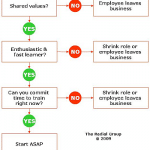How often do you say, “I just don’t know where my time goes?” For wellness leaders, your time is your most valuable asset. Here’s how to protect it:
What works:
1. Use one calendar.
Keep all of your business AND personal commitments in one place. Trying to keep multiple calendars in synch is simply impossible. That’s especially true when you need to handle personal matters – like a parent/teacher meeting — during normal business hours, and handle business matters — like hosting an open house for health club members and their friends – during the evening.
2. Your schedule should fit you, not vice-versa.
It’s smart to plan your schedule around your own energy peaks and valleys. Many of us try to power through how we feel, right? We’re drowsy and unmotivated at 3 p.m., but we sit through the staff meeting anyway. We add little to the discussion, and get little out of it.
If you’re most mentally energetic at 9 a.m., schedule that intense meeting first thing. When you know your pattern is a mid-afternoon flat-line, starting formally scheduling a fifteen-minute break on your daily calendar. Get a well-balanced snack and take a short walk outside.
3. The vital few, the trivial many.
The 80/20 principle states that 20% of your effort produces 80% of your results. For example, 20% of your sales reps probably generate 80% of your club memberships. 20% of your personal trainers probably account for 80% of your happiest clients.
The 80/20 rule reminds you to focus on the 20% of the work you do that REALLY matters.
Apply the 80/20 rule to your calendar. Look at this week’s calendar. How much of your time fell into the vital 20% category? And how much fell into the time-consuming but much less valuable 80% category.
You’ll probably find that you’re spending very little time on critical “move the business forward” activities. Instead you’re probably spending time on an employee performance problem that’s persisted for six months, attending meetings on which picture of a woman should go on the brochure cover, and choosing the food for the summer picnic.
Make a list of what’s chipping away at your time and develop specific plans to get your time back for more important work. That might mean promptly terminating that persistent problem employee, having your assistant make the food decisions for the picnic, and trusting that you’ve provided enough context for the graphic designer to choose the right brochure picture.
4. Keep a single to-do list.
Keep one — and only one — list of all of your to-do items. Many people find it useful to break to-do lists into categories based on where you can actually do the work. This approach makes it easier to focus just on the tasks that you’re actually capable of performing when you find yourself with uncommitted time.
For example, if you’re in your car or traveling frequently, consider a list called “Cell phone” of tasks you can do via phone. Another list called “Computer” could contain tasks that require you to be online.
Two other useful categories are:
- the “someday/maybe”list. These ideas aren’t must-do items. Instead, they’re interesting ideas that you may want to act on in the future. Park your middle-of-the night, sitting-at-a-traffic light inspirations here. Take a look at it no more than once every three or four months.
- the “waiting for” list. As a manager, you’re constantly handing off activities to staff, vendors, customers and others. Keep a list of what you’ve handed off and who owes you a response by when. Check it weekly and follow up as needed.
David Allen’s Getting Things Done is the single best approach to taking control of your to-do list that we’ve seen. (Leslie’s note: In fact, I personally have the paperback, hardcover and audio versions.)
5. Increase the odds that you’ll make smart decisions.
Plan a weekly or every-other-week review of your calendar (prior week, this week, and the next two weeks) and to-do list (skip the “someday/maybe section).
Here’s why: reminding yourself of what’s coming up helps you make smart decisions today about how to spend your time.
For example, say your 1 p.m. meeting is cancelled. You could just kill the hour wandering around, surfing the web, or browsing through old emails…but if you’ve reminded yourself about a presentation due in two weeks, perhaps instead you’ll choose to grab some coffee, seize the moment, and outline your main talking points now.
What doesn’t work:
1. Don’t mistake your memory for a planning tool.
Relying on your memory to remember new ideas, important next steps, and other items is ridiculous. It doesn’t work, and the constant background noise of “What was I trying to remember?” drains your mental energy.
We said above that a single calendar and a single to-do list are the two most powerful tools for controlling how you invest your time.
Here’s a third important tool: a reliable way to capture new ideas so that you can add them to your calendar or to-do list.
Where do you usually have new ideas or fresh insights about how to tackle a problem? Is it in the middle of the night? While you’re driving? Or working out?
Make sure you’ve got a way to capture ideas in every place that they’re likely to pop up. That may mean a notepad by the bed, leaving yourself voice messages by cell when you’re in the car, an index card in the pocket of your running shorts, a voice-recorder to use when you’re on the airplane.
Then, when you do the weekly review we described above, check all these places. Collect all your notes and move them to your to-do list or calendar, as appropriate.
2. Ready, fire, aim.
Hope is not a plan. Wishful thinking is the enemy of progress. Avoid the “Ready, Fire, Aim” syndrome when you decide to do something.
Say you’re thinking about a postcard marketing campaign to get new customers.
Quickly lay out a timelime so that key activities happen in the right sequence. For example, if you know you’re adding a new in-demand class in three months, time your postcard campaign accordingly.
Of course, adding that class may mean that you need to buy program supplies, make changes to your facility and hire new staff, so put that on your timeline too.
By the time you’ve listed all these items, you may well realize that the timing of the postcard and the class need to change. Better to find that out now so that you don’t waste your marketing budget and disappoint customers.
3. I’m just a girl who can’t say “not right now.”
Are you like the character in the musical “Oklahoma! who sings “I’m just a girl who can’t say no?”
Health and wellness business leaders are often afraid to say no to business opportunities. Yet spreading yourself thin and over-committing limited resources is a sure way to achieve nothing.
Write down your top three priorities for the next ninety days. These priorities should pass the following test: “If we got nothing else done but this, would we have moved the business forward?”
Now’s the simple — but not easy — part. Start saying “not right now” when other opportunities pop up. Don’t say “no, never.”
Keep your options open by letting folks know that you’ve got other priorities right now, but you’d like to keep this new idea on the list and explore it later.
4. Majoring in the minors
If you look back at your day and wonder where the time went, try this exercise. Keep track of ALL of your time in 15-minute blocks for 3 – 5 days. Then, review your calendar.
You’ll probably find that urgent – but not terribly important – stuff chipped away at the important work you originally planned.
5. Forget Mr. Right. How about Mr. Right Now?
We’ve seen health clubs and yoga studios show up for incredibly important presentations without a single piece of marketing material because they waffled so long over graphics and text color that they missed printing deadlines. We’ve seen general managers of frantically busy wellness centers go for a year without an assistant manager because “I just can’t find the right person.”
Perfectionism is the enemy of results. Get on with it!




